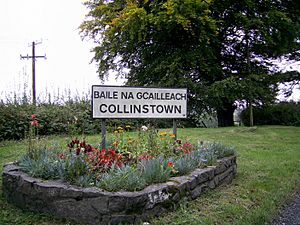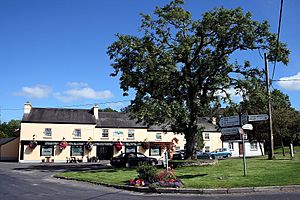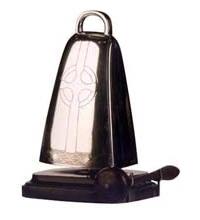Collinstown facts for kids
Quick facts for kids
Collinstown
Baile na gCailleach
|
|
|---|---|
|
Village
|
|

Bilingual welcome signage
|
|
| Country | Ireland |
| Province | Leinster |
| County | Westmeath |
| Elevation | 128 m (420 ft) |
| Population
(2016)
|
356 |
| Time zone | UTC+0 (WET) |
| • Summer (DST) | UTC-1 (IST (WEST)) |
| Irish Grid Reference | N500673 |
Collinstown is a small village in the northern part of County Westmeath, Ireland. It sits on the R395 regional road and looks out over the beautiful Lough Lene. The village is about 18 kilometers (11 miles) northeast of Mullingar, which is the main town in the county. In 2016, about 356 people lived in Collinstown.
Contents
What's in a Name?
The Irish name for Collinstown is Baile na gCailleach. This means 'town of the veiled women' or 'town of the hags'. This name comes from a time long ago when a convent, a home for religious women, was built on an island in Lough Lene.
A Look Back in Time
Collinstown has been a place where people lived for a very long time, even before Christianity came to Ireland.
Ancient Forts and Vikings
West of the village, in an area called Ranaghan, you can find the remains of several ringforts. These were circular forts built for protection. One of these forts is thought to have belonged to a famous Viking chief named Turgesius. He was known for taking over Dublin. Turgesius built these forts on high ground overlooking Lough Lene to defend himself. He lived there until he was killed by Máel Sechnaill mac Maíl Ruanaid, who was a High King of Ireland. Turgesius also had another fort on the largest island in Lough Lene, which is still called Turgesius Island today.
Early Christian Connections
The area also has old burial grounds linked to Saint Colman. He was important for creating seven early Christian paths. These paths allowed pilgrims to walk through fields to attend Sunday mass, especially during tough times when practicing their religion was difficult.
Collinstown also has strong ties to different religious groups. Besides the convent on Nun's Island in Lough Lene, the famous Fore Abbey monastic complex is located to the north.
The Lough Lene Bell
In 1881, an old bell was found by a boy who was fishing for eels on Castle Island in Lough Lene. This island was part of the Barbavila estate, owned by William Barlow Smythe. In 1882, Smythe gave this "Lough Lene Bell" to the Royal Irish Academy. Because it was found close to Fore Abbey, Smythe thought the bell might have belonged to St Feichin's Abbey. During times of trouble with the Vikings and Anglo-Normans, it might have been moved to Nun's Island and then hidden on Castle Island.
The bell has a faint outline of a Christian Celtic cross on opposite sides. It also has a decorative border. Smythe noted that decorations like this were usually only found on the cases or shrines that held bells, not on the bells themselves. This made the Lough Lene Bell very special. It looks similar to two other bells from the early Christian period. One was found in Bangor, County Down in 1832, and another in Cashel, County Tipperary in 1849.
Smythe believed the Lough Lene Bell was from the same time as these 7th-century bells. This supported his idea that it could have been a special item belonging to St. Feichin.
The original bell is now kept in the National Museum. However, a half-sized copy of the bell is proudly used as the Ceann Comhairle's (speaker's) bell in Dáil Éireann, which is the Irish parliament. This copy was given to the Dáil in 1931 by the wife of Major Bryan Cooper, who was a member of parliament. More recently, another copy of the bell was made. You can see this copy on display in St Mary's (Roman Catholic) Church in Collinstown and also in St Feichin's church in Fore.
The Barbavilla Estate
The Barbavilla estate has a long history. In 1670, William Smyth, who was a bishop, bought the Ranaghan estate for £1,100. This estate later became known as Barbavilla. It used to belong to the Luttrell family, but they lost it because of their involvement in the civil wars of the 1640s. William Smyth's third son, also named William, inherited the estate. Around 1730, he built a house on it and named it Barbavilla, after his wife Barbara.
During the 1800s, the Barbavilla House and Estate provided many jobs for people in the area. Stone houses, farm buildings, and animal shelters were built for employees around Barbavilla and Collinstown. These old stone buildings, including the former school, are now protected by local heritage laws. A special feature of these buildings is their roofing tiles. These tiles were made from local red clay and baked right on the Barbavilla estate. Some of these remaining buildings can be identified by small moss-green circles.
Since 1964, Barbavilla has been home to a company that makes car parts. It was first called the Irish Aluminium Company (Iralco). In 2008, the company changed hands and was renamed C&F Automotive. Later, former employees of the original Iralco factory bought it, and it now operates as Decotek Automotive.
Sports and Activities
Hurling
Lough Lene Gaels is the local hurling club. It was formed in 1969 when several local hurling clubs joined together. These included clubs from Collinstown, Fore, Glenidan, and Rickardstown. The club has won the Westmeath Senior Hurling Championship seven times since 1975. The Gaels have a friendly rivalry with their nearby team, Castlepollard GAA.
Water Sports
At a spot on Lough Lene called "The Cut," which is about 2 kilometers north of the village, you can enjoy many water activities. These include swimming, sailing, wind-surfing, and authorized fishing. There are also jetty facilities for boats.
Other Sports
Collinstown also has a local pitch and putt club, where you can enjoy a fun game of golf.
Education
Scoil Mhuire Naisiúnta (St Mary's N.S.) is the local primary school in Collinstown.
See also
 In Spanish: Collinstown para niños
In Spanish: Collinstown para niños




